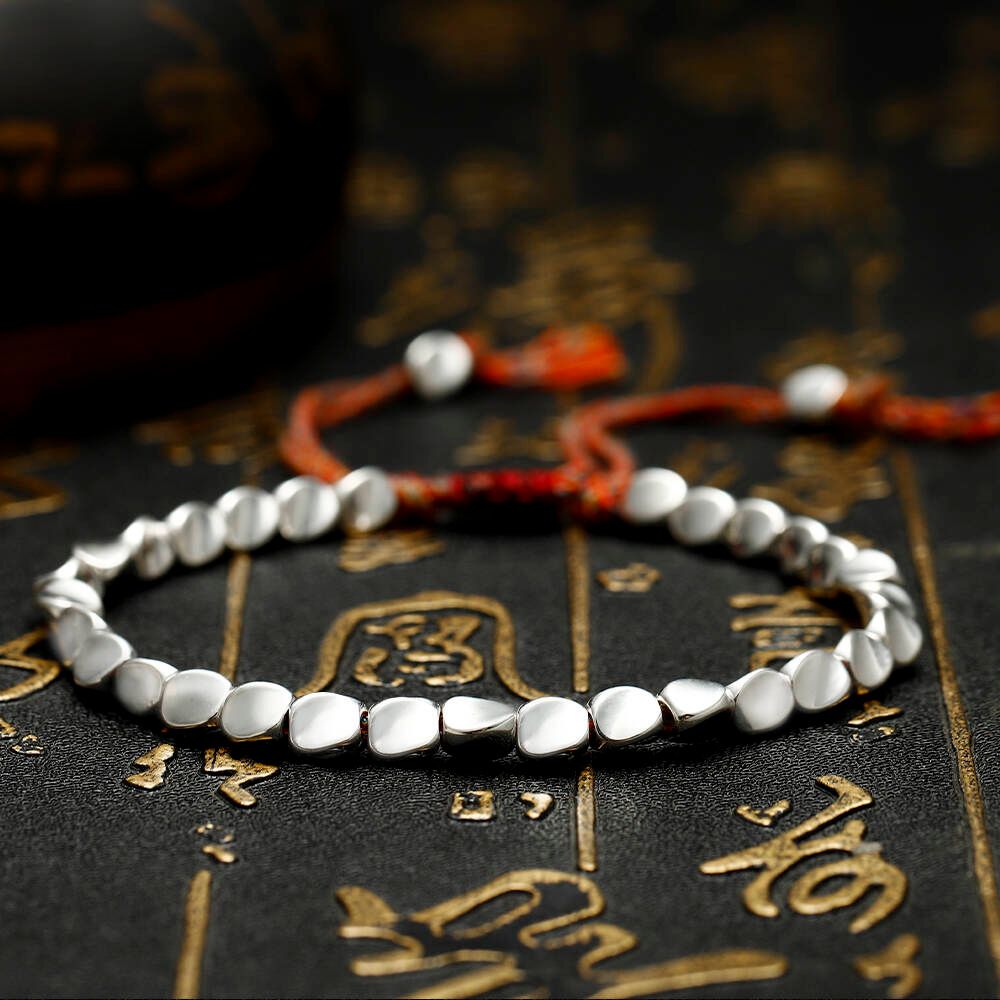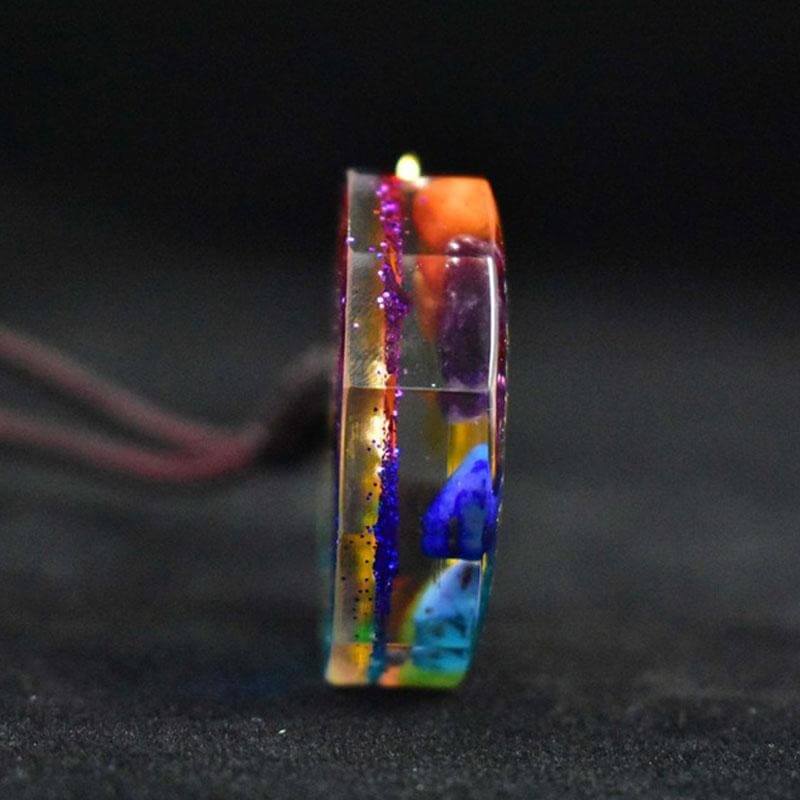Have you ever wondered if the amethyst bracelet you’re looking at is the real deal or just an imitation?
With amethyst jewelry becoming increasingly popular, it's essential to know how to differentiate real pieces from imitations. But not everyone has access to specialized tools or can conduct a lab test.
The good news is that there are DIY ways to help spot fake amethyst bracelets. By observing color, clarity, and even hardness with simple tests at home, you can be more confident of the authenticity of your bracelet and make informed decisions.
Real vs Fake Amethyst Bracelet: Key Differences
In a hurry? Check out our quick guide to determine if you’re looking at a real amethyst gem or not:
|
Feature |
Real Amethyst |
Fake Amethyst |
|
Color |
Varies from pale lavender to deep purple. May have natural color zoning or gradual shifts in color intensity. |
Uniform color throughout. May appear too vibrant or artificially consistent. |
|
Inclusions |
Amethyst may have natural inclusions or flaws, like "feathers" or other mineral inclusions. |
Typically clear and flawless, especially if it's made from glass or synthetic material. |
|
Temperature |
Natural gemstones tend to feel cooler than the ambient temperature, especially when touched for the first time. |
Fake gemstones, especially plastic ones, might feel closer to room temperature or warmer. |
|
Hardness Level |
Amethyst has a hardness level of 7 in the Mohs scale. It should not be easily scratched by common materials. |
Glass or plastic fakes might be softer and can be scratched more easily. |
|
Price |
Generally more expensive due to its natural origin and the processes involved in mining and crafting. |
Typically cheaper. If a deal seems too good to be true, it might be a fake. |
|
Specific Gravity |
Amethyst has a specific gravity number of about 2.65. This can be tested using special equipment. |
Imitations might have a different specific gravity, but this test can be more complex and may not be practical for most people. |
5 DIY Ways to Verify Amethyst at Home
If you’re looking to enjoy some promised amethyst bracelet benefits, you should ensure you’re getting a genuine piece. Here are some ways you can test the gem at home without using specialized tools or needing a lab test.
1. Inspect the Color of the Amethyst Beads
Authentic amethyst stones have a color range from pale lavender to deep purple. Look for natural color variations or zoning. Color zoning is when a gemstone has different shades in different areas, instead of one consistent color throughout. Fakes may have too consistent or overly vibrant colors.
2. Conduct a Scratch Test with Common Household Items
A real amethyst gem has a hardness level of 7 on the Mohs scale, meaning it should not be easily scratched by common objects like glass or metal. If your bracelet shows no signs of scratching from these materials, there's a good chance it's authentic. To determine the hardness of your amethyst bracelet, you can perform a scratch test using various household items made of these materials.
3. Examine Clarity for Natural Imperfections
By examining the clarity of your amethyst, you can look for natural imperfections that are common in real gemstones. Genuine amethyst often contains tiny inclusions and internal fractures that are visible upon closer look. If your bracelet appears flawless or lacks these natural imperfections, it might not be real.
4. Feel the Temperature on Warm Skin
Another way to test the authenticity of an amethyst bracelet is by assessing its temperature sensitivity. Real amethyst tends to feel cool when placed against warm skin due to its excellent heat conductivity properties. If your bracelet remains warm or doesn't exhibit this cooling effect, it could be an indication that it's not genuine.
5. Conduct a Fog Test
Breathe on the amethyst gem to fog it up. If the fog disappears quickly, it's more likely to be genuine. Fakes, especially those made of glass, retain the fog longer.
Signs of a Fake Amethyst Bracelet
Synthetic or Glass Imitations
One of the key red flags to watch out for when determining if an amethyst bracelet is real or fake is the presence of synthetic or glass imitations. Real amethyst gemstones possess unique properties that set them apart from their counterfeit counterparts. Cheap imitations lack these distinct characteristics, making them easy to identify as fakes.
Unusually Vibrant Colors
While real amethyst gemstones come in various shades of purple, ranging from light lavender to deep violet, counterfeit pieces often display overly bright and intense hues that are not typical of authentic amethyst.
Consistent Color
Aside from vibrancy, you should also check for color zoning. Fake amethyst stones have consistent color throughout. The real deal have different shades or intensities in different parts of the gem.
Too Perfect
Another sign that can help you spot a fake amethyst gem is its appearance. If the stone is absolutely flawless, with no inclusions or natural imperfections, it might be synthetic or an imitation.
Scratches Easily
Amethyst has a hardness level of 7 in the Mohs scale. If it gets scratched easily by materials that shouldn't be able to scratch it, like a coin, it might not be genuine.
Poor Craftsmanship
The craftsmanship and quality of the setting can also serve as indicators of a counterfeit amethyst bracelet. Fake pieces tend to exhibit poor craftsmanship, with visible flaws such as uneven cuts or rough edges. They may be set in low-quality materials that do not complement the beauty and durability typically associated with genuine amethyst jewelry.
Low Price
If the price seems too good to be true, especially for a piece that's described as high-quality or large, it's a red flag.
By being aware of these signs and paying attention to detail, you can better distinguish between a real and fake amethyst bracelet. It's important to remember that genuine amethyst possesses unique properties, exhibits natural color variations within the purple spectrum, and is crafted with attention to detail using high-quality materials.
What Makes an Amethyst Bracelet Real?
Origin and Formation of Genuine Amethyst Gemstones
Real amethyst gems are formed deep within the Earth's crust over millions of years. These beautiful purple stones are a type of quartz crystal that gets its color from trace amounts of iron and other minerals. They are typically found in geodes or as crystalline masses. Some notable locations where amethyst can be mined include Brazil, Uruguay, Canada, and North America. When buying amethyst, always ask the origin of the gemstone.
Authenticity Markers for Real Amethyst Bracelets
To ensure you're getting a genuine amethyst bracelet, look for certain authenticity markers. Sometimes, amethyst bracelets come with a certification from a reputable gemological institute or laboratory. This certification verifies the authenticity and quality of the gemstone.
Also, rely on trusted sources when purchasing an amethyst bracelet. Reputable jewelers and well-known brands have a reputation to uphold, so they are more likely to sell authentic pieces.
Use of High-Quality Materials in Crafting Genuine Amethyst Bracelets
Real amethyst bracelets are crafted using high-quality materials that enhance the beauty and durability of the gemstone. The setting should be made from solid metals like sterling silver or gold, ensuring longevity and preventing tarnishing.
Furthermore, real amethyst bracelets often feature meticulous craftsmanship with attention to detail. The stones should be securely set in place without any signs of glue or unevenness.
Mastering the Art of Identifying Real Amethyst
Congratulations! You are now equipped with the knowledge to confidently identify a real amethyst bracelet.
By understanding the key differences between real and fake amethyst, recognizing signs of a fake, knowing what makes an amethyst bracelet authentic, and using DIY methods to determine authenticity at home, you can now make an informed decision when buying an amethyst jewelry.
Now that you can tell a real amethyst bracelet from a fake one, it's time to put your newfound knowledge into action. Whether you're shopping for yourself or looking for the perfect gift, remember to apply these techniques to ensure you're getting an authentic piece of jewelry.
Don't be fooled by counterfeit products. Trust your instincts and use the knowledge you've gained here to get the real deal.
FAQs
What is the need to differentiate between real and fake amethysts?
It's essential to know the difference to ensure you're getting the true value for your money. Real amethysts are beautiful gemstones that have a unique hue and structure, while fake amethysts might not offer the same benefits.
Can the naked eye spot inconsistencies in the quality of amethyst?
While some inconsistencies might be noticeable with the naked eye, especially in low-quality fake gemstones, using a magnifying glass can give a clearer view of things like bubbles, cracks, and surface irregularities.
How does the purple color help in determining the authenticity of amethyst?
Amethyst, also known as purple quartz, has a distinct hue. However, it comes in different varieties, from light purple to dark purple. Fake amethysts might not replicate this hue accurately.
What questions should I ask a dealer during a sale?
Ask about the origin of the amethyst crystals, the cut, and whether they can provide information about the gem. It might also help to inquire if they have any accreditation, such as being a graduate gemologist or accredited appraiser.
What role does the hardness scale play in distinguishing real from fake amethysts?
True amethyst falls at a particular point on the hardness scale. Testing its resistance to a knife or other sharp object can provide insights. Fake crystals, especially synthetic stones, might not match the hardness of authentic gems.
Is weight a good measurement to determine if an amethyst bracelet is real?
Not necessarily. While there might be some weight differences between natural and synthetic amethyst, other factors, such as cut and size, can also impact the weight.
Are there any terms or names for different varieties of amethyst?
Yes, amethyst comes in various names like desert amethyst, natural aa, light purple, medium purple, and dark purple. However, be cautious, as some names might be coined for marketing fake stones.
How can professional testing help?
Professional testing by a jeweler or gemologist can provide accurate information about the amethyst's quality, structure, and authenticity. They often use advanced tools that can differentiate between synthetic and natural amethyst.
Where can I find more tips and information about identifying authentic amethyst bracelets?
This article offers a comprehensive list of tips and words of advice. Consulting with professionals and reading up from accredited sources will further ensure you have the real thing.
Why do some amethysts have bubbles or cracks?
Bubbles are typically a sign of synthetic stones. However, natural amethyst might have internal structures or inclusions, but these differ from the bubbles seen in fake crystals. Cracks, on the other hand, can be a result of the way the amethyst was cut or natural occurrences within the stone.
What about synthetic amethyst? Is it always bad?
Synthetic amethyst has its place in the market, and not everyone considers it "bad." However, it's essential to know whether you're buying natural or synthetic so you can assess its true value.
















Leave a comment